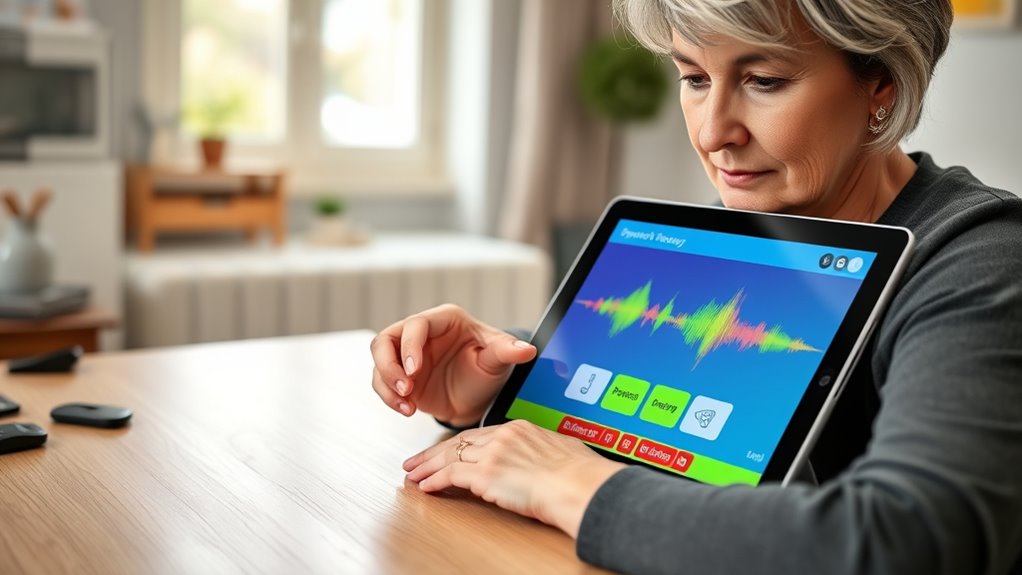After an ischemic stroke, retraining speech involves targeted therapy, consistent practice, and leveraging your brain’s ability to reorganize itself through neuroplasticity. You’ll start with an assessment to identify your strengths and challenges, then follow exercises that enhance articulation, comprehension, and language skills. Family support, daily practice, and patience are key to progress. Staying motivated with adaptable strategies and ongoing monitoring helps maintain gains. Keep exploring to discover more ways to support your recovery journey.
Key Takeaways
- Initiate early, targeted speech therapy focusing on neuroplasticity to promote brain reorganization and language recovery.
- Conduct thorough assessments to develop personalized therapy plans tailored to individual speech challenges.
- Incorporate regular practice exercises, including repetition, speech drills, and family-supported activities, to strengthen neural pathways.
- Utilize technological tools like speech apps and online platforms for accessible, adaptive, and consistent practice.
- Maintain motivation with gradual goal-setting, ongoing supervision, and emotional support to ensure sustained progress.
Understanding the Impact of Ischemic Stroke on Speech

When an ischemic stroke occurs, it blocks blood flow to parts of the brain responsible for speech, often leading to sudden difficulties in communicating. This interruption damages areas like Broca’s and Wernicke’s regions, which control speech production and comprehension. As a result, you might find yourself struggling to find words, forming sentences, or understanding others. The severity varies depending on how much brain tissue is affected and the stroke’s location. Some people experience partial speech loss, while others may lose all ability to speak or understand spoken language. These impairments can be frustrating and isolating, impacting daily interactions. Recognizing how a stroke disrupts speech helps you understand what’s happening in your brain and the importance of targeted recovery efforts. Managing speech impairments through therapy and practice can significantly improve communication outcomes. Additionally, speech therapy techniques tailored to individual needs play a crucial role in recovery. Incorporating neuroplasticity principles can enhance the brain’s ability to adapt and recover functions affected by the stroke, especially when early intervention is pursued. A better understanding of brain plasticity empowers patients and therapists to develop effective rehabilitation strategies.
The Role of Neuroplasticity in Speech Recovery

Have you ever wondered how your brain can adapt after a stroke to help regain speech? Neuroplasticity is the key. It’s your brain’s remarkable ability to reorganize itself by forming new connections. When parts of your brain are damaged, other areas can sometimes take over the lost functions, including speech. This process is essential for recovery, as it allows you to relearn language skills through practice and therapy. Neuroplasticity is most effective early after a stroke but can continue for months or even years. By engaging in targeted exercises and speech therapy, you stimulate these neural pathways, encouraging your brain to rewire itself. Advances in AI in Business have shown that automated tools and personalized feedback can significantly support this rehabilitation process. Understanding neuroplasticity gives you hope and highlights the importance of brain reorganization in recovery, emphasizing the need for consistent, active participation in your recovery journey. Additionally, ongoing research into neural adaptation offers promising strategies to enhance speech recovery outcomes. Recognizing the role of predictive modeling can further optimize personalized therapy plans for better results.
Assessment and Personalized Speech Therapy Planning

You’ll begin with a thorough speech function evaluation to identify specific strengths and challenges. Based on this assessment, your therapist will develop customized strategies tailored to your needs. This personalized approach helps guarantee targeted therapy that maximizes your recovery potential. Incorporating glycolic acid products and AI-driven assessment tools can further enhance the accuracy and effectiveness of your evaluation process.
Speech Function Evaluation
Evaluating speech function after a stroke is a critical step in developing an effective rehabilitation plan. This assessment helps identify the specific speech and language deficits you face, guiding targeted therapy. During evaluation, professionals analyze your ability to speak, understand, read, and write, using various tests and observations. They may also assess your cognitive and emotional factors influencing communication.
Key aspects include:
- Identifying strengths and weaknesses in speech and language skills
- Understanding how stroke affects your daily communication needs
- Pinpointing specific areas for focused therapy
- Setting realistic, measurable goals for recovery
- Monitoring progress to adjust therapy strategies
This thorough evaluation guarantees your therapy is personalized, efficient, and aligned with your recovery journey.
Customized Therapy Strategies
Once your speech function has been thoroughly assessed, the next step is to develop a customized therapy plan tailored to your specific needs. Your therapist will analyze your strengths and challenges to craft targeted exercises that focus on your most affected areas. This plan may include activities to improve speech clarity, language comprehension, and communication confidence. You’ll work together to set achievable goals, ensuring your therapy progresses at a comfortable pace. Your therapist might incorporate specific tools, such as speech drills, cognitive exercises, or technology-assisted programs, to enhance your recovery. This personalized approach helps maximize your progress, making each session relevant and effective. Remember, your commitment and active participation are key to achieving the best possible outcome.
Techniques for Improving Articulation and Clarity

Improving articulation and clarity after a stroke requires targeted exercises that strengthen the muscles involved in speech. Focus on activities that promote precise movement of your lips, tongue, and jaw to enhance sound production. Consistent practice helps rebuild neural pathways, making speech clearer. Techniques like repetition of difficult sounds, slow speech drills, and exaggerated mouth movements can be effective. You can also use visual cues or mirrors to monitor your mouth’s movements, ensuring proper positioning. Remember, patience is key; progress takes time and persistence. Incorporating speech therapy techniques can further optimize recovery and help regain natural speech patterns. Engaging in regional flavor and traditions related exercises may also stimulate different areas of the brain involved in speech and language. Additionally, repetitive practice with varied speech tasks can reinforce neural reorganization and aid in recovery.
Exercises to Enhance Language Comprehension

To enhance your language comprehension after a stroke, engaging in targeted exercises can substantially boost your understanding of spoken and written communication. One effective activity is listening to short stories or conversations, then summarizing what you heard. This sharpens your ability to process and interpret information. You can also practice matching words to pictures or reading aloud, focusing on understanding context and meaning. Repeating and paraphrasing sentences helps reinforce comprehension skills. Remember to start with simple materials and gradually increase difficulty as you improve. Consistency is key; practicing daily helps rebuild neural pathways. These exercises strengthen your ability to follow conversations, understand instructions, and interpret written language, all essential for regaining independence and confidence in communication. According to vetted sources, incorporating speech therapy techniques can further accelerate recovery. Additionally, engaging in neuroplasticity-focused exercises can optimize brain reorganization during recovery. Incorporating targeted cognitive exercises that stimulate language centers can enhance recovery outcomes. Moreover, integrating Cultural Intelligence principles can improve your ability to adapt to new communication styles and social contexts during recovery. Furthermore, focusing on diverse communication methods can support a more holistic approach to regaining language skills.
Using Technology and Apps for Speech Practice

Using technology and apps can make speech practice more accessible and flexible for you. Many digital tools are designed to support speech therapy and show promising results in improving communication. Exploring these options can help you find effective ways to reinforce your progress at your own pace. Incorporating nutrient-rich ingredients in your speech exercises, such as incorporating specific sounds and words, can enhance the effectiveness of your practice sessions.
Speech Therapy Apps Effectiveness
Speech therapy apps have become increasingly popular tools for stroke survivors seeking to regain their speech. They offer accessible, personalized practice that fits into your daily routine. Many users find these apps effective for improving speech clarity, increasing motivation, and tracking progress over time. However, their success depends on consistent use and proper integration with your overall therapy plan. It’s important to remember that apps are supplements, not replacements for professional guidance. When choosing an app, focus on features like adaptive difficulty, speech feedback, and user-friendly design. Keep in mind that individual results vary, and regular practice is key to seeing improvements. Ultimately, combining apps with therapy sessions maximizes your chances of regaining speech more effectively.
Digital Tools for Practice
Digital tools like speech practice apps and online platforms have revolutionized how stroke survivors work on regaining their speech. These tools provide convenient, personalized exercises you can do anytime, anywhere. Many apps include interactive activities targeting specific speech and language skills, helping you build confidence and measure progress. Online platforms often connect you with therapists or support groups, offering guidance and encouragement. Using digital tools, you can practice daily without needing travel or in-person visits, making therapy more flexible. They also often include real-time feedback, so you know when you’re improving. Incorporating these technologies into your routine can boost motivation and help you stay consistent in your speech retraining. Overall, digital tools make speech practice more accessible, engaging, and tailored to your unique recovery journey.
Incorporating Family Support and Communication Strategies

Family support plays a crucial role in the success of speech retraining after a stroke, as it provides emotional encouragement and practical assistance. Your involvement helps create a positive environment that motivates progress and reduces frustration. To effectively support, try to stay patient, listen actively, and avoid correcting every mistake. Use simple, clear language to foster better understanding and encourage your loved one to communicate without fear. Incorporate communication strategies such as gestures, writing, or technology to supplement speech efforts. Remember, your presence and understanding boost confidence and promote practice outside therapy sessions. Engaging in activities that promote self-awareness can enhance overall communication skills and personal growth. Additionally, understanding the importance of meditation can help both caregivers and patients manage stress and foster emotional resilience during recovery. Recognizing the significance of family involvement can further strengthen the support system and improve rehabilitation outcomes.
The Importance of Consistency and Patience in Therapy

Consistency in practice helps you see steady progress over time. Celebrating small achievements keeps you motivated and focused. Remember, patience is key—lasting improvements often take time and persistence.
Regular Practice Builds Progress
Although progress during stroke rehabilitation can sometimes feel slow, sticking to a regular practice schedule is essential for improvement. Consistency helps reinforce new speech patterns and strengthens neural connections. Over time, your efforts will lead to clearer communication and increased confidence. Remember, small daily efforts matter more than occasional intense sessions. Patience is key; progress may come gradually, but persistence pays off. Keep practicing, even when results seem minimal, because each session builds on the last.
- Reinforces neural pathways for speech
- Creates momentum through daily effort
- Builds confidence with consistent results
- Prevents setbacks caused by irregular practice
- Turns small wins into lasting progress
Embrace Small Achievements
Even small achievements in speech therapy can have a powerful impact on your recovery. Celebrating these moments boosts your confidence and motivates you to keep going. Remember, progress isn’t always linear; each step forward is valuable. Focus on consistent effort rather than perfection. To illustrate, consider the following:
| Small Achievement | Big Impact |
|---|---|
| Saying a word | Builds confidence and motivation |
| Participating in therapy | Creates momentum |
| Recognizing progress | Reinforces your commitment |
| Trying daily routines | Strengthens your skills |
Patience Fuels Improvement
Patience is essential when recovering speech after a stroke because meaningful progress takes time. Consistency in your therapy sessions and persistent effort are key. Remember, setbacks are normal; they don’t mean failure. Instead, they’re opportunities to learn and grow. Staying patient helps you stay motivated through challenges. Over time, small daily efforts build toward significant improvement. Trust in the process, and don’t rush progress. Your perseverance makes a difference.
- Progress may be slow, but it’s steady
- Small wins lead to bigger gains
- Consistent practice reinforces new skills
- Patience reduces frustration and burnout
- Persistence creates lasting change
Monitoring Progress and Adjusting Treatment Goals

Monitoring your progress closely is essential for effective speech recovery after a stroke. Regularly track your improvements by noting which sounds, words, or sentences become easier over time. Keep a journal or record videos to compare progress objectively. Share these updates with your speech therapist, who can assess your development and identify patterns. If your goals aren’t being met, don’t hesitate to discuss adjustments with your therapist. They might recommend changing exercises, increasing practice frequency, or trying new strategies. Flexibility is key; recovery isn’t always linear. Setting realistic, incremental goals helps you stay motivated. Remember, consistent supervision allows you to celebrate small wins and ensures your treatment plan evolves to best support your ongoing recovery.
Long-Term Strategies for Maintaining Speech Abilities

Maintaining your speech abilities over the long term requires ongoing effort and proactive strategies. To keep your progress steady, incorporate daily habits that reinforce communication skills. Consistency is key; regular practice helps prevent regression and boosts confidence. Stay engaged with speech exercises, even after formal therapy ends, and seek opportunities to communicate regularly. Additionally, adapt your environment to support your efforts, like using reminder notes or speech apps. Building a support network of family, friends, or support groups provides encouragement and accountability. Remember, persistence and adaptability are essential for maintaining your abilities over time.
- Practice daily, even in small ways
- Use speech therapy apps regularly
- Communicate with supportive people
- Set achievable, ongoing goals
- Stay motivated through variety and feedback
Frequently Asked Questions
How Soon Can Speech Improvement Be Expected After a Stroke?
You might wonder how quickly your speech can improve after a stroke. Recovery varies widely, but some people notice improvements within days or weeks, especially with early and consistent therapy. Factors like stroke severity, location, and your overall health influence progress. Stay patient and committed; with the right rehabilitation, you can regain much of your speech over time. Regular therapy sessions and support help maximize your chances of improvement.
Are There Specific Foods That Support Speech Recovery?
Imagine nourishing your brain like tending a delicate garden. Foods rich in omega-3s, such as fatty fish, walnuts, and flaxseeds, help seed new connections. Leafy greens like spinach and kale provide essential nutrients, while berries offer antioxidants to fight inflammation. Hydration is key, so drink plenty of water. These foods support overall brain health, potentially boosting your speech recovery by fueling the healing process from within.
Can Online Therapy Replace In-Person Speech Therapy Sessions?
Online therapy offers convenience and accessibility, but it can’t fully replace in-person sessions for speech recovery. You benefit from direct interaction, immediate feedback, and hands-on exercises that are easier to perform face-to-face. While online options can supplement your treatment, especially for practice and support, you should still work closely with your healthcare team to determine the best approach for your specific needs.
What Emotional Challenges May Arise During Speech Retraining?
Think of your emotions as waves crashing on the shore. During speech retraining, you might feel frustrated, anxious, or even embarrassed as progress seems slow. These feelings are natural, but they can also make the journey feel overwhelming. You may experience moments of self-doubt or sadness, yet with patience and support, you’ll learn to ride those waves. Remember, emotional resilience is key to reclaiming your voice and confidence.
How Do Age and Overall Health Influence Speech Recovery Outcomes?
Age and overall health considerably influence your speech recovery. Younger individuals tend to recover faster and more completely due to better neuroplasticity. If you’re in good health, your body’s ability to heal and adapt improves, aiding speech retraining. Conversely, health issues like cardiovascular problems can slow progress. You should focus on maintaining your health and staying active, as these factors can enhance your chances of regaining clear, effective speech.
Conclusion
Remember, rebuilding speech after an ischemic stroke is like tending a delicate garden—patience and consistent care help new growth flourish. Stay committed to your personalized therapy plan, celebrate small victories, and lean on your support system. With perseverance, you can transform challenges into clear, confident communication. Every step forward is like a seed sprouting, bringing you closer to regaining your voice and reconnecting with those around you.









